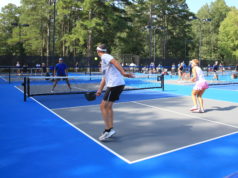Page Love, M.S., R.D., CSSD, USPTA
Do you get confused with nutrition labels, especially when you are trying to pick appropriate sport nutrition choices for your training diet? Well, welcome to the new Nutrition Facts Label, which was approved this year and will slowly appear on food products soon, including sport foods.
This label has some new focuses that may be helpful in key nutrient areas, in particular calories, added sugars and updated serving sizes and newly added potassium.
See what’s new:

Other labeling terms that have been around for a while and are helpful when looking at labels for sport nutrition choices include:
Fortified: Fortified foods have nutrients added to them that weren’t there originally. Milk, for example, is fortified with vitamin D, a nutrient that helps you absorb milk’s calcium and is now being connected with numerous disease prevention aspects. Calcium is also an electrolyte athletes lose in sweat, so it is an important nutrient to have in recovery foods such as chocolate milk.
Enriched: Enriched foods have nutrients added to them to replace those lost during food processing. B vitamins, for example, are lost when wheat is processed into white flour, so these nutrients are later added back. B vitamins, also known as energy vitamins, help metabolize energy from foods. B vitamins are also often found in energy bars and recovery beverages that may help with meeting increased needs for these nutrients that occur during sport expenditure.
Sodium: While sodium (commonly called salt) is generally considered a nutrient that adults are encouraged to limit, it is vital for healthy nerves and muscles. Read food labels to help keep your sodium intake to at least 2,300 milligrams to meet your sweat losses on the tennis court. Some adult male players may need between 5,000 and 10,000 milligrams per day.
Sugar: Sugar is considered an “evil” nutrient to many parents, but remember that sugar is a simple energy source for quick anaerobic movement on the court. Small amounts of sugar in energy bars and sport beverages are needed for palatability and quick energy for the tennis player, but you can be on the lookout for these definitions:
1. Reduced sugar: At least 25 percent less sugars per serving than an appropriate reference food; and
2. “No added sugars” and “without added sugars” are allowed if no sugar or an ingredient containing sugar is added during processing.
Labeling Carbohydrates in Sports Foods
Common carbohydrates that will soon be appearing on nutrition labels include the following:
Monosaccharides or simple sugars: glucose, galactose, fructose
Disaccharides, also simple sugars: lactose, sucrose, maltose, trehalose
Sugar alcohols, often used as sugar substitutes to lower carbohydrate content: sorbitol, maltitol, lactitol, erythritol, xylitol, mannitol
Polysaccharides, or complex carbohydrates in starch form: amylopectin, amylose, modified food starches
Non-starch form: cellulose, hemicellulose, pectins, b-glucans, inulin fructans, gums, mucilages, algal polysaccharides.
Tennis players need a combination of simple and complex carbs to provide both quick energy and longer lasting energy that will stabilize blood sugars longer and provide fuel for longer periods of time. Too much fiber in a sport food can cause digestive discomfort and may want to be avoided right before tennis play.
Unfortunately, many tennis players are being influenced by the media with a focus on lower carbohydrate diets and products and may not choose pre- and post-match choices that aren’t high enough in carbohydrate to appropriately help them fuel and recover from matches. When we apply this information to choosing an energy bar, for example, keep the following guidelines in mind:
Higher carbohydrate: Look for sports bars with 20 or more grams of total carbohydrates with less than one-third of the composition coming from sugar. Best before or on the court, these bars are very similar to the nutrition of a bagel in a bar. Examples include Power Bar Protein Plus, Clif, Gatorade Fuel Bar, Pro Bar and Odwalla.
Higher protein: Bars that contain 20 grams or more protein are best for after matches because they are too high in protein to digest quickly before a match. Examples include EAS Whey, Gatorade Recovery Bar and Power Bar Protein.

How to Read a Sports Drink Label
Many tennis players are concerned that they shouldn’t consume calories on the court. If you have a long ALTA match, you may need energy on the court in the form of simple carbohydrates, and you most definitely need electrolytes. For carbohydrates, an appropriate level is approximately 14 grams of carbohydrates per 8 ounces to encourage rapid fluid replenishment (this is a 6 percent carbohydrate concentration).
Also look at the source of the carbohydrates on the ingredient listing. High fructose levels can cause gastrointestinal distress and can slow absorption. Multiple carbohydrate sources from simple carbohydrates are preferred because this helps increase fluid absorption.
As mentioned earlier, sodium is the primary electrolyte lost in sweat, so look for beverages with adequate sodium. A sodium level of about 100-110 milligrams (which actually meets low sodium labeling guidelines) per 8 ounces enhances the taste, facilitates quick absorption and maintains body fluids more effectively. Water alone lacks sodium and may decrease your drive to drink and may decrease fluid balance as do the slight sodium contents of most sport beverages.
Illustrations courtesy Food and Drug Administration
_______
Page Love is a consultant for the ATP and WTA professional tennis tours and a member of USTA Sport Science Committee. For more information, contact her at nutrifitga.com.




